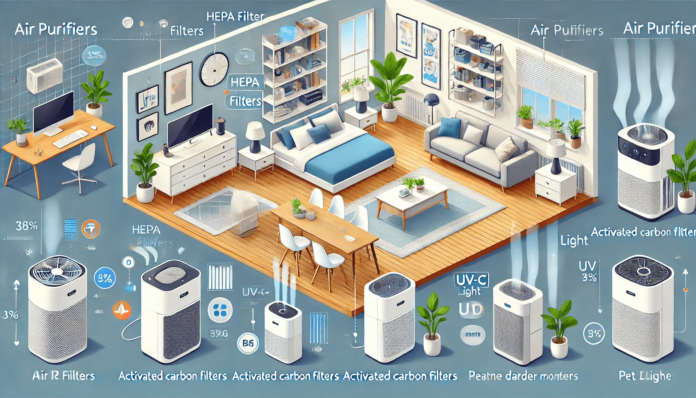Introduction
- Why Do You Need an Air Purifier?
- Key Considerations When Choosing an Air Purifier
- Additional Features to Look For
- Top Air Purifier Recommendations for Different Needs
- Avoid These Common Pitfalls When Purchasing an Air Purifier
- Understanding Technical Terms
- How to Maintain Your Air Purifier
- Choosing Air Purifiers: Factors to Consider Before Buying
- Conclusion
- FAQs
Choosing the perfect air purifier can be daunting with a wide array of options to consider and varying features to evaluate. This comprehensive guide simplifies the process, helping you with choosing air purifiers tailored to your specific needs. From understanding room size requirements to comparing filter types, this best air purifier guide ensures you make an informed decision. Whether you need relief from allergies, pet dander, or smoke, we’ll cover everything you need to know to find the perfect air purifier for your home or office.
Why Do You Need an Air Purifier?
Air purifiers effectively eliminate harmful particles from the air, including dust, pollen, smoke, mold spores, and pet dander, ensuring a cleaner breathing environment. They are especially beneficial for:
- Allergy sufferers: Reducing exposure to allergens like pollen and dust mites.
- Asthma patients: Minimizing triggers such as smoke and chemical irritants.
- Homes with pets: Controlling pet dander and odors.
- Urban areas: Reducing exposure to smog and fine particulate matter (PM2.5).
Key Considerations When Choosing an Air Purifier
1. Room Size and Coverage Area
The size of the room plays a significant role in selecting an air purifier. Manufacturers usually specify the square footage an air purifier can effectively cover.
Tips:
- Measure your room’s size before purchasing.
- Look for models with a CADR (Clean Air Delivery Rate) rating to gauge efficiency in removing particles.
2. Type of Air Filter
The type of filter determines the efficiency and purpose of an air purifier.
Common Filter Types:
- HEPA (High-Efficiency Particulate Air): Captures 99.97% of particles as small as 0.3 microns, ideal for allergies and asthma.
- Activated Carbon Filters: Absorbs odors, smoke, and VOCs (volatile organic compounds).
- UV-C Light: Kills bacteria and viruses, though it may not capture particulate matter.
- Washable Filters: Cost-effective but less effective than HEPA filters.
3. Air Quality Concerns
Identify the primary issue you want to address.
Recommendations Based on Concerns:
- Allergens: Choose a model with a True HEPA filter.
- Smoke and Odors: Opt for an air purifier with an activated carbon filter.
- Viruses and Bacteria: Select a unit with UV-C technology or ionizers.
4. Noise Levels
Air purifiers operate continuously, so noise levels are crucial for comfort.
Tips:
- Check decibel ratings (dB) for quiet performance.
- Consider models with a sleep mode for bedrooms.
5. Energy Efficiency
Look for ENERGY STAR-certified air purifiers to save on electricity bills.
Additional Features to Look For
1. Smart Features
Modern air purifiers come with advanced features such as:
- Wi-Fi connectivity for remote control via smartphone apps.
- Real-time air quality monitoring and display.
2. Portability
If you need to move your air purifier between rooms, consider lightweight models with handles or wheels.
3. Maintenance and Filter Replacement
Filter replacement is an ongoing cost. Look for models with:
- Affordable and readily available filters.
- Filter change indicators to simplify maintenance.
Top Air Purifier Recommendations for Different Needs
1. Best for Allergies: Honeywell HPA300
- Features: True HEPA filter, covers 465 square feet, multiple cleaning levels.
- Why It’s Great: Reliable allergen removal for medium to large rooms.
2. Best for Pet Owners: Levoit Core P350
- Features: True HEPA 3-stage filtration, pet-specific filter, compact design.
- Why It’s Great: Effectively handles pet dander and odors.
3. Best for Smoke: Blueair Blue Pure 211+
- Features: HEPASilent technology, activated carbon filter, ENERGY STAR certified.
- Why It’s Great: Excellent for removing smoke and odors in large spaces.
4. Best for Bedrooms: Coway AP-1512HH Mighty
- Features: HEPA filtration, auto mode, eco-friendly operation.
- Why It’s Great: Quiet performance and compact design perfect for smaller rooms.
Avoid These Common Pitfalls When Purchasing an Air Purifier
- Ignoring Room Size: Buying an underpowered model can result in inefficient air purification.
- Overlooking Filter Costs: Choose models with affordable and durable filters.
- Choosing Style Over Function: Focus on performance metrics like CADR over aesthetic design.
- Not Considering Noise Levels: Loud units can disrupt sleep and daily activities.
Understanding Technical Terms
1. CADR (Clean Air Delivery Rate):
Indicates the speed at which an air purifier effectively removes pollutants from the air within a given space. A higher CADR signifies greater efficiency in purifying the air and removing pollutants from your space.
2. ACH (Air Changes Per Hour):
Indicates how many times the air purifier can filter the room’s air in an hour. A higher ACH is better for areas with heavy pollution.
How to Maintain Your Air Purifier
- Clean or Replace Filters Regularly: Follow manufacturer recommendations to ensure efficiency.
- Keep Air Vents Unobstructed: Place the unit in an open area for optimal airflow.
- Wipe Down the Exterior: Prevent dust buildup that could hinder performance.
Choosing Air Purifiers: Factors to Consider Before Buying

When it comes to choosing air purifiers, several factors can help you make the best decision for your space and needs. Air purifiers vary in design, size, and functionality, so it’s important to identify your priorities. Are you looking to combat allergens, eliminate smoke, or control pet odors? Understanding your primary concerns will guide you toward the right model.
Key Considerations:
- Room Size: Measure your room and select an air purifier with the appropriate coverage area.
- Filter Type: HEPA filters are ideal for allergens, while activated carbon filters handle odors and VOCs.
- Noise Levels: Choose a quieter model for bedrooms or workspaces.
Conclusion
Choosing the best air purifier for your needs requires evaluating factors like room size, air quality concerns, and filter types. By understanding your priorities and comparing features, you can find a model that delivers cleaner, healthier air. With the right air purifier, you can breathe easier, improve your health, and create a comfortable indoor environment for your family.
FAQs
Q: What is the ideal budget for purchasing an air purifier?
A: Determine your budget based on your room size and specific needs.
Q: Are air purifiers safe to use 24/7?
A: Yes, most are designed for continuous operation. Choose an energy-efficient model for long-term use.
Q: Can one air purifier cover multiple rooms?
A:Air purifiers are generally optimized to purify the air in a single room at a time. Consider portable options for flexibility.














